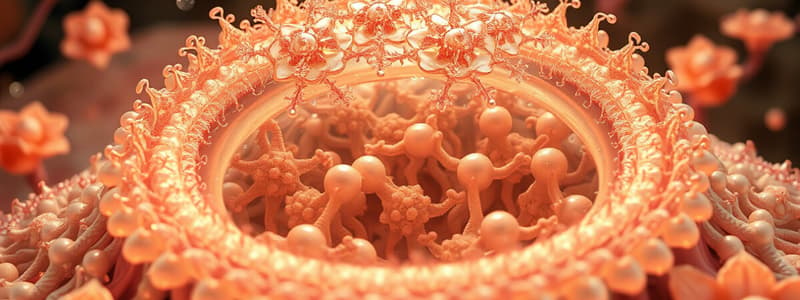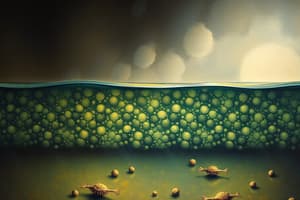Podcast
Questions and Answers
Which type of transport does NOT require energy?
Which type of transport does NOT require energy?
- Facilitated transport (correct)
- Primary active transport
- Simple diffusion (correct)
- Active transport
What characterizes facilitated diffusion?
What characterizes facilitated diffusion?
- Does not involve concentration gradients
- Requires energy input
- Occurs only with small nonpolar molecules
- Involves a membrane protein (correct)
In the context of osmosis, which statement is true regarding water movement?
In the context of osmosis, which statement is true regarding water movement?
- Water moves towards a higher concentration of impermeable solutes (correct)
- Water moves against its concentration gradient
- Aquaporin channels decrease the movement of water
- Water movement is influenced solely by the concentration of permeable solutes
Which statement about osmolarity is correct?
Which statement about osmolarity is correct?
Which of the following molecules is likely to move via simple diffusion?
Which of the following molecules is likely to move via simple diffusion?
Flashcards are hidden until you start studying
Study Notes
Passive Transport
- Passive transport occurs without energy expenditure from the cell.
- Includes simple diffusion and facilitated transport.
- Active transport requires energy and features primary and secondary active transport.
Simple Diffusion
- Involves the movement of molecules driven by random thermal motion.
- The direction of net flux is determined by concentration gradients.
- Achieves diffusion equilibrium with equal movement in both directions.
- No carrier proteins are needed; molecules must be permeable to the lipid bilayer (examples: fatty acids, gases, steroids).
Facilitated Diffusion
- Requires membrane proteins for transport.
- Involves ion channels that allow ions to cross the lipid bilayer, often gated by factors like ligands or voltage.
- Carrier-mediated facilitated diffusion transports molecules from high to low concentrations, requiring specific binding and conformational changes of the carrier protein.
GLUT Transporters
- Classic example of carrier-mediated transport, specifically for glucose.
- The operation of transporters can change depending on intracellular glucose concentration.
Osmosis
- Described as the passive diffusion of water across a selectively permeable membrane.
- Aquaporin channels enhance water movement as they facilitate the transport of polar molecules.
- Movement of water is influenced by the number of osmotically active particles present, following the concentration gradient.
Osmolarity
- Refers to the concentration of osmotically active particles in a solution, calculated as Osm/L.
- Formula: Posm = n * C * RT, where 'n' is the number of particles, and 'C' is concentration.
- Example: 150 mM NaCl represents 2 Osm due to ion dissociation.
Osmotic Pressure
- Net water movement is dictated solely by the concentration of impermeable solutes.
- Impermeable solutes contribute to osmotic pressure, whereas permeable solutes do not.
- Osmotic pressure formula: π = φ n * C * RT, where φ is the permeability factor (0 for permeable, closer to 1 for impermeable solutes).
Studying That Suits You
Use AI to generate personalized quizzes and flashcards to suit your learning preferences.




